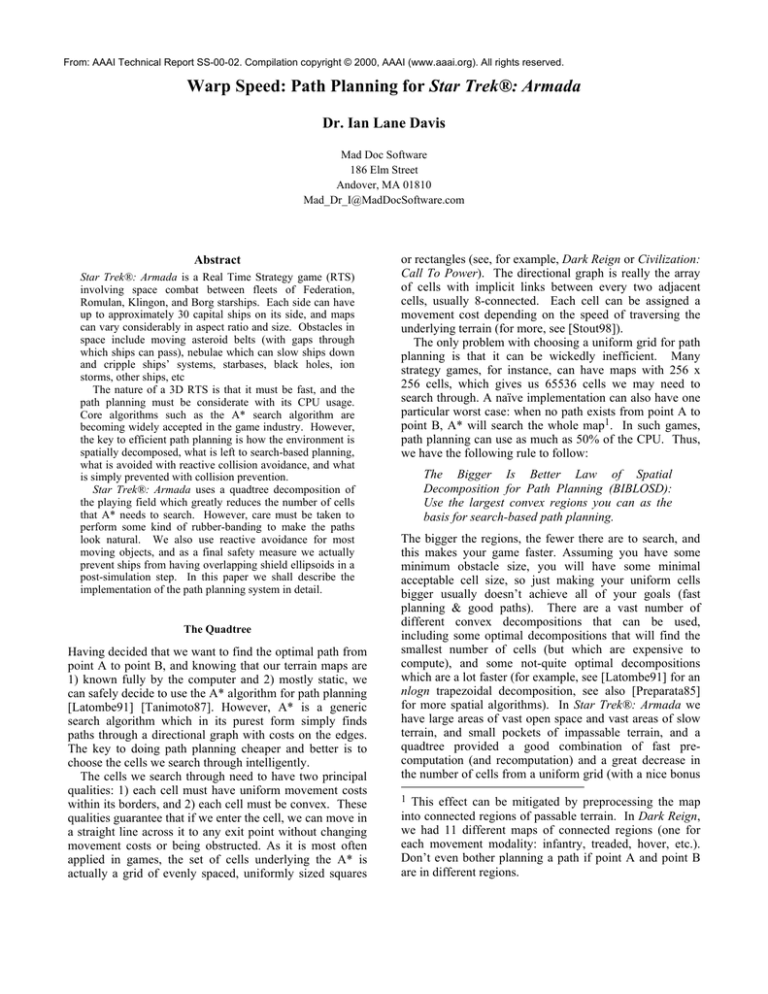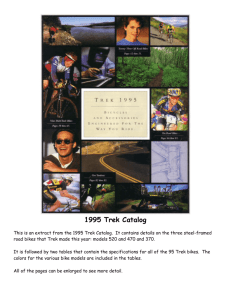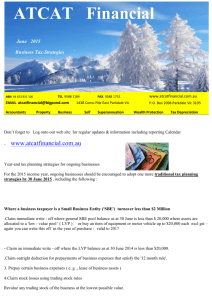
From: AAAI Technical Report SS-00-02. Compilation copyright © 2000, AAAI (www.aaai.org). All rights reserved.
Warp Speed: Path Planning for Star Trek®: Armada
Dr. Ian Lane Davis
Mad Doc Software
186 Elm Street
Andover, MA 01810
Mad_Dr_I@MadDocSoftware.com
Abstract
Star Trek®: Armada is a Real Time Strategy game (RTS)
involving space combat between fleets of Federation,
Romulan, Klingon, and Borg starships. Each side can have
up to approximately 30 capital ships on its side, and maps
can vary considerably in aspect ratio and size. Obstacles in
space include moving asteroid belts (with gaps through
which ships can pass), nebulae which can slow ships down
and cripple ships’ systems, starbases, black holes, ion
storms, other ships, etc
The nature of a 3D RTS is that it must be fast, and the
path planning must be considerate with its CPU usage.
Core algorithms such as the A* search algorithm are
becoming widely accepted in the game industry. However,
the key to efficient path planning is how the environment is
spatially decomposed, what is left to search-based planning,
what is avoided with reactive collision avoidance, and what
is simply prevented with collision prevention.
Star Trek®: Armada uses a quadtree decomposition of
the playing field which greatly reduces the number of cells
that A* needs to search. However, care must be taken to
perform some kind of rubber-banding to make the paths
look natural. We also use reactive avoidance for most
moving objects, and as a final safety measure we actually
prevent ships from having overlapping shield ellipsoids in a
post-simulation step. In this paper we shall describe the
implementation of the path planning system in detail.
The Quadtree
Having decided that we want to find the optimal path from
point A to point B, and knowing that our terrain maps are
1) known fully by the computer and 2) mostly static, we
can safely decide to use the A* algorithm for path planning
[Latombe91] [Tanimoto87]. However, A* is a generic
search algorithm which in its purest form simply finds
paths through a directional graph with costs on the edges.
The key to doing path planning cheaper and better is to
choose the cells we search through intelligently.
The cells we search through need to have two principal
qualities: 1) each cell must have uniform movement costs
within its borders, and 2) each cell must be convex. These
qualities guarantee that if we enter the cell, we can move in
a straight line across it to any exit point without changing
movement costs or being obstructed. As it is most often
applied in games, the set of cells underlying the A* is
actually a grid of evenly spaced, uniformly sized squares
or rectangles (see, for example, Dark Reign or Civilization:
Call To Power). The directional graph is really the array
of cells with implicit links between every two adjacent
cells, usually 8-connected. Each cell can be assigned a
movement cost depending on the speed of traversing the
underlying terrain (for more, see [Stout98]).
The only problem with choosing a uniform grid for path
planning is that it can be wickedly inefficient. Many
strategy games, for instance, can have maps with 256 x
256 cells, which gives us 65536 cells we may need to
search through. A naïve implementation can also have one
particular worst case: when no path exists from point A to
point B, A* will search the whole map1. In such games,
path planning can use as much as 50% of the CPU. Thus,
we have the following rule to follow:
The Bigger Is Better Law of Spatial
Decomposition for Path Planning (BIBLOSD):
Use the largest convex regions you can as the
basis for search-based path planning.
The bigger the regions, the fewer there are to search, and
this makes your game faster. Assuming you have some
minimum obstacle size, you will have some minimal
acceptable cell size, so just making your uniform cells
bigger usually doesn’t achieve all of your goals (fast
planning & good paths). There are a vast number of
different convex decompositions that can be used,
including some optimal decompositions that will find the
smallest number of cells (but which are expensive to
compute), and some not-quite optimal decompositions
which are a lot faster (for example, see [Latombe91] for an
nlogn trapezoidal decomposition, see also [Preparata85]
for more spatial algorithms). In Star Trek®: Armada we
have large areas of vast open space and vast areas of slow
terrain, and small pockets of impassable terrain, and a
quadtree provided a good combination of fast precomputation (and recomputation) and a great decrease in
the number of cells from a uniform grid (with a nice bonus
1
This effect can be mitigated by preprocessing the map
into connected regions of passable terrain. In Dark Reign,
we had 11 different maps of connected regions (one for
each movement modality: infantry, treaded, hover, etc.).
Don’t even bother planning a path if point A and point B
are in different regions.
of being a fairly straightforward implementation compared
to many other convex decompositions). See Figure 1, for a
screenshot of the quadtree in the game.
3.
4.
5.
the current cell (trivially true).
Skip the
remaining steps.
Since the current cell is divided, recurse to all
four children.
Create the list of internal cells that border our
north border by merging the north border lists of
our northeast and northwest children. Make
similar lists for our internal cells that border our
east, west, and south edges. These lists are used
for making neighbor links outside of our cell.
Create neighbor links for our internal cells. There
are four internal borders: top & bottom (vertical),
and left & right (horizontal). For the right border,
create a neighbor link between each cell in the
northeast child’s south border list and each cell in
the southeast child’s north border list.
An example of a neighbor graph superimposed on a
quadtree is shown in Figure 2. Note that the links are
directional, although for simplicity they are not shown as
such.2
Figure 1: Federation &Borg ships in a game map with
quadtree gridlines overlaid.
Preprocessing the map consists of three steps:
1.
2.
3.
Add all regions of high terrain cost
Simplify the quadtree
Extract the graph of neighboring cells
For the quadtree, you start with the map logically
considered to be one big empty cell. When you add a
region of higher cost, you recursively do the following:
1.
2.
If the added region entirely covers the current
cell, set the current cell’s cost to the new cost.
Otherwise, divide the current cell into four equal
size quarters, and recursively add the new region
to each child cell.
In this fashion, you add all regions of higher cost to the
map. In our game, the slow regions are nebulae (five
different flavors each with its own speed) and asteroid
belts. The impassable regions are asteroid fields, black
holes, starbases, and a few other special objects. When
they are all added, step 2 has us go through the quadtree
and take any divided cell that happens to end up with four
children of equal terrain cost, and undivided it (which
happens frequently when lots of small similar regions are
added in). Note that this step could be integrated into step
1 if desired.
Finally, the graph of neighboring cells needs to be
extracted from the quadtree (we use a 4-connected
quadtree). This is done recursively, and each step of the
recursion has several steps:
1. If the current cell is impassable, skip all
remaining steps
2. If the current cell is undivided, add it to list of
cells that border the north, south, east, and west of
Figure 2. The neighbors graph for a quadtree
Path planning is now a simple matter of performing A* on
the graph. However, the paths can be ugly, and can
actually take a ship a fair bit out of its way if we just move
it through the centers of these cells. In fact, all convex
decompositions create path-shape artifacts.
Even a
uniform grid creates artifacts, as in many games the
units/characters always move at 45 degree or 90 degree
angles as they pass through 8-connected cells. The one
large side effect of the BIBLOSD is that bigger cells have
more obvious artifacts; figure 3 shows a path with such
artifacts. What we need to do is to consider the results of
2
In Star Trek: Armada we created directional links out of
impassable cells, but not into them since the physics
system and other special effects could sometimes move a
ship into what should be impassable region (this is not
shown in the diagram)
the A* as a list of which cells to pass through, and perform
some sort of rubber banding on the path in order to pull it
tight to the edges we want to follow.
which we can draw a straight line from the current point
and not have the line exit any of the cells on our path. If
we are at point 6 on the path, and the current LVP is 3, we
can safely eliminate points 4 and 5 from the path since we
have a valid straight line from 3 to 6. Whenever the LVP
changes, we eliminate any points between the old LVP and
the last point before the LVP became invalid.
In fact, this operation is also linear in the length of the
path. When we move from a point across a border into the
next cell, two rays define “Visibility Regions” from the
LVP. As we go along our phase 1 path, the Visibility
Region from the LVP can only shrink. Once we encounter
a point which is not in the Visibility Region, we make the
point just before it the new LVP, and we eliminate points
between the old and the new LVPs. This gives us our final
path.
Figure 3. A not entirely good path
Rubber Banding, Step 1
Our solution has two steps: 1) We find the best corners of
the cell to go to, and 2) We eliminate unnecessary points
on the path. In the first step, we take advantage of the A*
code we already have for searching for the best path on a
generic directed graph. We create a secondary A* graph
which includes as nodes only the start and end points and
the corners of the shared edges of each pair of connected
cells on our path. Each node then is linked just to the two
nodes on the next edge we cross on the path. We then
perform a second A* search. Although A* in general can
be slow, since we are only connecting the cells forwards,
and each cell is only connected to two other cells, the
second A* is linear to the length of the path. Figure 4
shows a better path that was found with this method.
Figure 4. Better, but not quite there. Left shows the
forward-linked-only A* graph. Right shows path.
Rubber Banding, Step 2
The final step is to move along the path from start to
finish, and maintain the LVP (Last Visible Point) on the
path. The LVP is defined as the earliest point on the path to
Figure 5. Visibility regions (left) and the final path (right)
Support Systems: Collision Avoidance & Collision Prevention
& Misc
We now have a fast system for path planning in Star
Trek®: Armada. Whenever a ship wants to move, it can
find a nice looking path efficiently. However, there are
still difficulties, and they are related to moving obstacles.
The system as we’ve implemented it does not plan paths
around moving obstacles, and in an efficient system like
this, the likelihood that two ships will take the same route
for part of their respective paths is high. Looking at the
path in Figure 5, it is easy to see that if a ship goes from
point A to point B while another is moving from anywhere
near B to anywhere near A their paths overlap in the lower
section.
We rely on collision avoidance and collision prevention
to keep the ships from smacking into each other. The
reactive collision avoidance is similar to systems used for
robots. We have two systems that we are evaluating. The
first uses potential fields [Latombe91] [Davis96] to apply
steering forces for the ships away from objects nearby.
The second evaluates a number of different steering arcs
[Kelly95] weighting obstacles negatively and the goal
(next point on path) positively, and chooses the highest
value arc.
The secondary system is called collision prevention, and
it has no analog in the real world. To make the ships look
intelligent and the starship pilots to appear reasonably
trained (and to prevent weapons from being fired within
another ship’s shields!) we must guarantee that under no
circumstances will two ships’ shield ellipsoids overlap.
Since there are many forces that can act on a ship (black
holes, explosions, special weapons, engines, etc.) we
simply do not allow overlap. To achieve this, on every
simulation cycle of the game, we look at each ship and
check it against each nearby ship (using geometric
hashing, aka buckets, for efficiency [Sedgewick92]). If the
shield ellipsoids overlap by any amount, we simply
separate the ships by that amount. In practice, this looks
fine due to the nice curves of the ellipsoids. As long as we
never let them overlap, and separation looks smooth.
Conclusions
Although the basics of path planning are beginning to be
understood within the computer game development
community, the key to planning paths efficiently is in the
proper decomposition of the playing field into convex
regions. Additionally, any convex decomposition from
uniform grids to optimal decompositions will result in the
paths having artifacts that can affect gameplay and reveal
too much of the underlying path planning structure to the
game player!
For Star Trek®: Armada we have chosen a quadtree
spatial decomposition and developed a two step rubber
banding approach to clean up the paths. In the first
mission of Star Trek®: Armada, in order to achieve the
same planning resolution in a uniform grid as we have in
the quadtree, we would have needed 16384 cells. The
quadtree, on the other hand, uses only 2191. This makes
both the average and worst case path searches with A*
significantly faster. Although there are more optimal
decompositions, the speed of pre-computation and the ease
of maintenance make this decomposition very appealing.
Furthermore, there is a linear time (in the length of the path
counted in cells traversed) two step clean up of the paths to
remove the artifacts of the decomposition from the final
path.
References
I. Davis, A Modular Neural Network Approach to
Autonomous Navigation, Ph.D. thesis, Carnegie Mellon
University, 1996.
A. Kelly, An Intelligent Predictive Control Approach to
the High-Speed Cross-Country Autonomous Navigation
Problem, PhD Thesis, Carnegie Mellon University, 1995.
J. C. Latombe, Robot Motion Planning, Kluwer Academic
Publishers, Boston, MA 1991.
F. P. Preparata and M. I. Shamos, Computational
Geometry: An Introduction, Springer-Verlag, 1985.
R. Sedgewick, Algorithms in C++, Addison-Wesley, 1992.
W.B. Stout, “Smart Moves: Intelligent Path-Finding”,
Game Developer Magazine, October 1996.
S. Tanimoto, The Elements of Artificial Intelligence,
Computer Science Press, Rockville, Maryland, 1987.
Acknowledgments. The author would like to thank
Activision and Paramount Pictures for the opportunity to
work on this project and for permission to publish results.
In particular, Scott Lahman, VP of the Activision LA
Studio has fostered an environment which encourages
advances in technology.
Star Trek: Armada is used with permission of
Paramount Pictures, Inc. and Activision, Inc. Star Trek:
Armada: TM, (R) & (C) 1999, 2000 Paramount Pictures.
All rights reserved. Star Trek and related marks are
trademarks of Paramount Pictures. Activision is registered
a trademark of Activision, Inc.
The image showing Federation and Borg ships may not
be redistributed (other than by the AAAI) without written
permission from Paramount Pictures and Activision.





